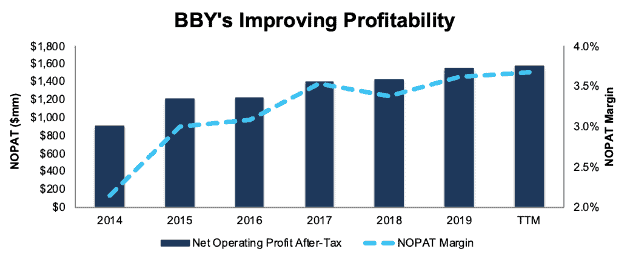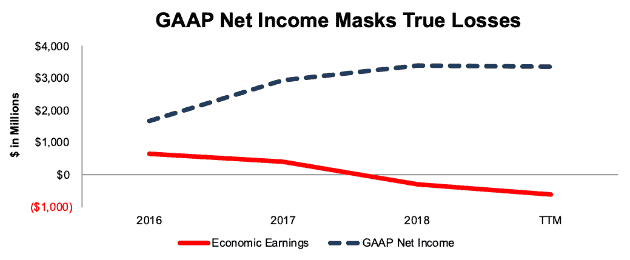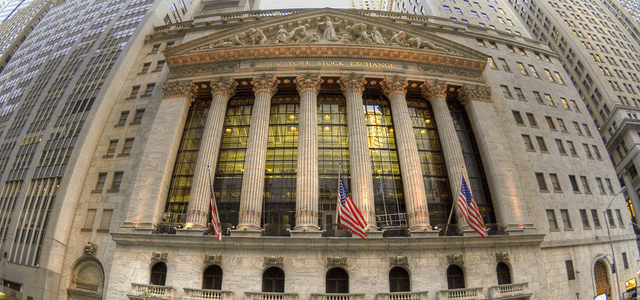23 new stocks make our Most Attractive list this month, and 26 new stocks fall onto the Most Dangerous list this month. June’s Most Attractive and Most Dangerous stocks were made available to members on June 5, 2019.
The successes of these model portfolios highlight the value of our machine learning and AI Robo-Analyst technology[1], which helps clients fulfill the fiduciary duty of care and make smarter investments[2].
Our Most Attractive stocks have high and rising returns on invested capital (ROIC) and low price to economic book value ratios. Most Dangerous stocks have misleading earnings and long growth appreciation periods implied by their market valuations.
Most Attractive Stocks Feature for June: Best Buy Co. (BBY: $66/share)
Best Buy (BBY: $66/share) is the featured stock from June’s Most Attractive Stocks Model Portfolio. We also made BBY a Long Idea in April 2018.
Since fiscal 2014, BBY has grown after-tax operating profit (NOPAT) by 11% compounded annually. BBY’s $1.6 billion NOPAT over the trailing twelve months (TTM) is up 11% over the prior TTM period. Rising NOPAT margins, which are up from 2% in fiscal 2014 to 4% TTM, drove this profit growth. BBY’s return on invested capital (ROIC) has also improved from 7% to 16% over the same time.
Figure 1: BBY NOPAT & NOPAT Margin Since Fiscal 2014

Sources: New Constructs, LLC and company filings
BBY Valuation Provides Significant Upside Potential
At its current price of $66/share, BBY has a price-to-economic book value (PEBV) ratio of 0.9. This ratio means the market expects BBY’s NOPAT to permanently decline by 10%. This expectation seems overly pessimistic for a firm that has grown NOPAT by 11% compounded annually since fiscal 2014.
If BBY can maintain TTM NOPAT margins (4%) and grow NOPAT by just 3% compounded annually for the next decade, the stock is worth $88/share today – a 33% upside. See the math behind this dynamic DCF scenario.
Critical Details Found in Financial Filings by Our Robo-Analyst Technology
As investors focus more on fundamental research, research automation technology is needed to analyze all the critical financial details in financial filings. Below are specifics on the adjustments we make based on Robo-Analyst findings in Best Buy’s fiscal 2019 10-K:
Income Statement: we made $513 million of adjustments, with a net effect of removing $85 million in non-operating expenses (<1% of revenue). You can see all the adjustments made to BBY’s income statement here.
Balance Sheet: we made $6 billion of adjustments to calculate invested capital with a net increase of $4.1 billion. One of the largest adjustments was $2.5 billion due to operating leases. This adjustment represented 47% of reported net assets. You can see all the adjustments made to BBY’s balance sheet here.
Valuation: we made $3.7 billion of adjustments with a net effect of decreasing shareholder value by $3.6 billion. Apart from $3.6 billion in total debt, which includes the operating leases noted above, the largest adjustment to shareholder value was $55 million in outstanding employee stock options. This option adjustment represents <1% of BBY’s market cap. See all adjustments to BBY’s valuation here.
Most Dangerous Stocks Feature: Mondelez International (MDLZ: $54/share)
Mondelez International (MDLZ) is the featured stock from June’s Most Dangerous Stocks Model Portfolio. We put MDLZ in the Danger Zone in March 2016 and again in April 2019. When we remove accounting distortions and calculate MDLZ’s economic earnings, which represent the true cash flows of the business, we find that MDLZ’s profitability declined.
From 2016 to 2018 MDLZ’s GAAP net income grew 43% compounded annually. Economic earnings fell from $508 million to -$413 million over the same time, per Figure 2. TTM GAAP net income is up 4% over the prior TTM period while TTM economic earnings are negative.
Figure 2: MDLZ’s GAAP Net Income Rises as Economic Earnings Fall

Sources: New Constructs, LLC and company filings
MDLZ Provides Poor Risk/Reward
Despite the deterioration in fundamentals, MDLZ is still priced for significant profit growth and is overvalued.
To justify its current price of $54/share, MDLZ must maintain 2018 NOPAT margins of 14% (after two consecutive years of decline) and grow NOPAT by 5% compounded annually for the next 13 years. See the math behind this dynamic DCF scenario. This expectation seems overly optimistic given that MDLZ’s NOPAT declined by 1% compounded annually over the past decade.
Even if Mondelez can maintain 2018 margins and grow NOPAT by 3% compounded annually (faster than most of its markets/segments) for the next decade, the stock is worth only $38/share today – a 30% downside. See the math behind this dynamic DCF scenario.
Critical Details Found in Financial Filings by Our Robo-Analyst Technology
As investors focus more on fundamental research, research automation technology is needed to analyze all the critical financial details in financial filings. Below are specifics on the adjustments we make based on Robo-Analyst findings in Mondelez’s 2018 10-K:
Income Statement: we made $2.6 billion of adjustments, with a net effect of removing $219 million in non-operating expenses (1% of revenue). You can see all the adjustments made to MDLZ’s income statement here.
Balance Sheet: we made $21.6 billion of adjustments to calculate invested capital with a net increase of $20.6 billion. One of the largest adjustments was $10.6 billion due to other comprehensive income. This adjustment represented 23% of reported net assets. You can see all the adjustments made to MDLZ’s balance sheet here.
Valuation: we made $26.2 of adjustments with a net effect of decreasing shareholder value by $25.7 billion. The largest adjustment to shareholder value was $20.4 billion in total debt, which includes $666 million in off-balance sheet operating leases. This lease adjustment represents 1% of MDLZ’s market cap. See all adjustments to MDLZ’s valuation here.
This article originally published on June 13, 2019.
Disclosure: David Trainer and Kyle Guske II receive no compensation to write about any specific stock, style, or theme.
Follow us on Twitter, Facebook, LinkedIn, and StockTwits for real-time alerts on all our research.
[1] Harvard Business School features the powerful impact of our research automation technology in the case New Constructs: Disrupting Fundamental Analysis with Robo-Analysts.
[2] This paper compares our analytics on a mega cap company to other major providers. The Appendix details exactly how we stack up.
